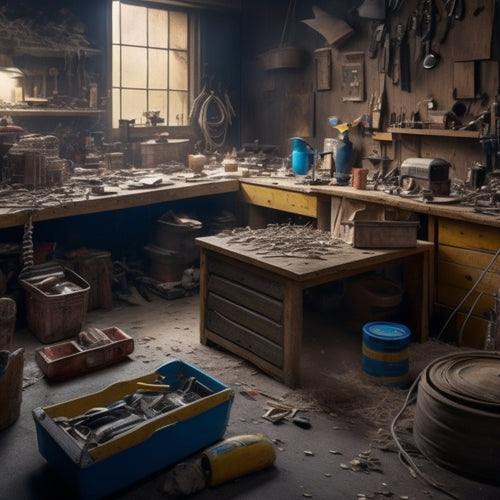
Top Wall Anchor Systems for Renovation Projects
Share
When renovating a space, you need a wall anchor system that can support the weight of your design vision. For heavy loads, toggle bolts, molly bolts, and sleeve anchors provide a secure hold. In solid concrete, high-strength anchor systems like sleeve anchors, wedge anchors, and epoxy anchors distribute load evenly. Easy-to-install anchors save time, while corrosion-resistant options like stainless steel and galvanized coatings guarantee durability. With specialized anchors for cracked concrete walls, high-traffic areas, and more, selecting the right system is essential. By understanding your project's unique needs, you can find the ideal anchor system to bring your vision to life, and exploring further will reveal even more tailored solutions.
Key Takeaways
• Choose the right anchor type based on the wall material, load capacity, and environmental conditions for a secure hold.
• Consider high-strength concrete anchor systems for heavy loads and seismic areas, ensuring a reliable hold.
• Opt for corrosion-resistant anchor options, such as stainless steel or galvanized coatings, for durability and longevity.
• Select specialized anchors for specific needs, like cracked concrete walls or high-traffic areas, to ensure a strong hold.
• Evaluate load capacity, environmental factors, and material compatibility when selecting a top wall anchor system for renovation projects.
Best Anchors for Heavy Loads
When dealing with heavy loads, you'll require anchors that can withstand immense pressure, and toggle bolts, molly bolts, and sleeve anchors are often the top choices for renovation projects.
These anchor types are designed to provide a high load capacity, making them ideal for supporting heavy fixtures, shelves, or equipment.
Toggle bolts, for instance, have a spring-loaded mechanism that expands when tightened, providing a secure hold in hollow walls.
Molly bolts, on the other hand, have a pointed tip that helps them drill into the wall, creating a strong anchor point.
Sleeve anchors, which consist of a sleeve and a bolt, offer a high load capacity and are suitable for both solid and hollow walls.
When selecting an anchor, consider the load capacity required for your project and choose an anchor type that can meet or surpass that capacity.
High-Strength Concrete Anchor Systems
You'll require high-strength concrete anchor systems for renovation projects that involve drilling into solid concrete, as these systems provide a reliable and secure hold for heavy loads and fixtures. These anchors are designed to distribute the load evenly, guaranteeing that the weight is transferred to the surrounding concrete, rather than relying on the anchor itself. This is especially important when working with heavy materials or in areas prone to seismic activity.
High-strength concrete anchor systems are made with high-strength materials that can withstand heavy loads and harsh environmental conditions. They are available in various types, including sleeve anchors, wedge anchors, and epoxy anchors.
| Anchor Type | Description |
|---|---|
| Sleeve Anchor | Expands when tightened, providing a secure hold |
| Wedge Anchor | Uses a wedge-shaped plug to anchor into concrete |
| Epoxy Anchor | Uses a strong epoxy adhesive to bond with concrete |
When selecting a high-strength concrete anchor system, consider the type of load, the weight of the fixture, and the environmental conditions of the installation site. By choosing the right anchor system, you can guarantee a safe and secure installation that will last for years to come.
Easy to Install Wall Anchors
When you're working on a renovation project, you'll appreciate the convenience of easy-to-install wall anchors that save you time and effort.
These anchors provide a quick and secure fix, eliminating the need for drilling, which can be a major hassle.
You'll also value the fact that they're hidden from view, ensuring a clean and professional finish.
Quick and Secure Fix
For renovation projects requiring a swift and reliable hold, easy-to-install wall anchors provide a hassle-free solution, streamlining the installation process and saving valuable time.
You can focus on the task at hand, knowing that your anchors will hold securely without the need for extensive expertise or specialized tools.
To guarantee a quick and secure fix, follow these essential tips:
-
Choose the right anchor: Select an anchor that suits the type of wall and the weight of the object you're hanging.
-
Drill accurately: Use a level and a drill bit of the correct size to avoid damaging the wall or the anchor.
-
Tighten correctly: Follow the manufacturer's instructions for tightening the anchor to avoid overtightening or stripping the screw.
- Test the hold: Before hanging your object, test the anchor's hold by gently tugging on it to confirm it's secure.
No Drilling Required
In situations where drilling is not an option, easy-to-install wall anchors that don't require drilling provide a convenient alternative, offering a secure hold without the need for extensive preparation or specialized tools. This type of anchor is ideal for renters, historic homes, or walls with sensitive surfaces. You can use them for various wall decoration projects, such as hanging shelves, mirrors, or artwork.
These no-drill anchors rely on alternative fastening methods, like adhesive strips or gripping mechanisms, to hold your items securely in place. Here are a few popular options:
| Anchor Type | Load Capacity | Surface Compatibility |
|---|---|---|
| Adhesive Strip Anchor | 10-20 lbs | Drywall, Plaster, Wood |
| Gripping Anchor | 20-30 lbs | Drywall, Plaster, Concrete |
| Spring-Loaded Anchor | 15-25 lbs | Drywall, Wood, Metal |
When choosing a no-drill anchor, consider the weight and size of your item, as well as the type of wall surface you're working with. By selecting the right anchor for your project, you can guarantee a secure and damage-free installation. With these easy-to-install anchors, you can complete your renovation project with confidence and ease.
Hidden From View
You can opt for hidden-from-view wall anchors that recess into the wall, providing a sleek, discreet installation that doesn't compromise on holding power. These anchors are perfect for renovation projects where aesthetics matter, as they offer invisible fastening and hidden supports. With these anchors, you can achieve a clean, minimalist look without sacrificing stability.
Here are some benefits of hidden-from-view wall anchors:
-
Concealed Installation: The anchor is recessed into the wall, making it almost invisible.
-
Easy to Install: Most hidden-from-view anchors come with a simple installation process that doesn't require specialized tools.
-
High Holding Power: Despite their discreet design, these anchors can hold significant weight and withstand heavy loads.
- Versatility: Hidden-from-view anchors can be used with various types of walls, including drywall, plaster, and wood.
When choosing a hidden-from-view wall anchor, consider the type of load you need to support, the wall material, and the desired level of discreetness.
Corrosion-Resistant Anchor Options
When you're specifying wall anchor systems for renovation projects, you'll want to take into account corrosion-resistant anchor options to guarantee durability and longevity.
You're likely looking for anchors that can withstand harsh environmental conditions, and that's where stainless steel options and galvanized anchor coatings come in.
Stainless Steel Options
Corrosion-resistant stainless steel wall anchor systems provide a reliable solution for securing heavy loads in renovation projects exposed to harsh environmental conditions, such as high humidity, saltwater, or chemical-laden air. When you're working on a project that demands the highest level of durability and resistance to corrosion, stainless steel anchors are an excellent choice.
Here are four key benefits of stainless steel wall anchor systems:
-
Unparalleled durability: Stainless steel anchors can withstand the most aggressive environments, ensuring your renovation project remains secure and stable for years to come.
-
Superior corrosion resistance: The unique properties of stainless steel make it impervious to rust and corrosion, even in the presence of saltwater or chemical-laden air.
-
Enhanced aesthetics: Stainless steel anchors offer a sleek, modern appearance that complements any renovation design, while also providing a high-end finish.
- Low maintenance: With stainless steel anchors, you'll enjoy a reduced need for maintenance and repairs, saving you time and resources in the long run.
Galvanized Anchor Coatings
Galvanized anchor coatings provide a reliable, cost-effective alternative to stainless steel systems, offering a robust barrier against corrosion in renovation projects where environmental conditions are less extreme.
You'll find that galvanized anchor coatings offer excellent durability, making them a suitable choice for projects where exposure to moisture and humidity is limited.
The galvanizing process involves applying a layer of zinc to the anchor, which forms a protective barrier that prevents corrosion from spreading. This results in a longer lifespan for your anchors, reducing the need for frequent anchor maintenance.
When selecting a galvanized anchor coating, consider the thickness of the zinc layer, as it directly impacts the anchor's corrosion resistance. A thicker layer generally provides better protection.
Additionally, look for anchors with a chromate conversion coating, which enhances the galvanized surface's corrosion resistance.
Anchors for Cracked Concrete Walls
During renovation projects, you'll often encounter cracked concrete walls that require reliable anchors to guarantee structural integrity and prevent further damage. When dealing with cracked walls, it's important to choose the right anchor system to make certain a secure hold and prevent further cracking.
Here are some key considerations for anchors in cracked concrete walls:
-
Anchor type: Select anchors specifically designed for cracked concrete, such as epoxy-based or chemical anchors, which provide a strong bond with the surrounding concrete.
-
Drilling technique: Use a slow, controlled drilling method to minimize vibrations and prevent further damage to the surrounding concrete.
-
Anchor placement: Position anchors in areas with minimal cracking to maximize holding power.
- Cracked wall repair: Consider repairing cracks before installing anchors to provide a solid substrate for the anchor installation.
Top Picks for Fastening Systems
Selecting the right fastening system for your renovation project involves evaluating various factors, including load capacity, environmental conditions, and material compatibility.
You'll want to take into account the type of load, whether it's static or dynamic, and the weight it'll be bearing. Environmental factors, such as moisture, temperature, and exposure to chemicals, should also be considered. Additionally, verify that the fastening system is compatible with the surrounding material, whether it's concrete, drywall, or wood.
When it comes to top picks for fastening systems, you may want to explore alternative fastening techniques, such as screw anchors, adhesive anchors, or hollow-wall anchors.
These options offer innovative anchor materials, like nylon or stainless steel, that provide superior holding power and corrosion resistance. For example, screw anchors with a coarse thread pattern can provide excellent grip in drywall, while adhesive anchors with an epoxy-based adhesive can bond strongly to concrete.
Anchors for High-Traffic Areas
When designing a renovation project that involves high-traffic areas, you must choose anchors that can withstand the increased stress and wear, guaranteeing the safety and integrity of the installation. High-traffic areas, such as commercial buildings, hospitals, or schools, require anchors that can handle the constant flow of people and heavy use.
To guarantee a successful wall anchor installation, consider the following anchor material types for high-traffic areas:
-
Stainless Steel Anchors: Resistant to corrosion and ideal for humid or wet environments.
-
High-Strength Nylon Anchors: Offer excellent holding power and are suitable for concrete, brick, or block walls.
-
Heavy-Duty Plastic Anchors: Provide a secure hold and are often used in high-traffic areas with drywall or plaster walls.
- Toggle Anchors: Feature a spring-loaded mechanism that expands when screwed into place, providing a strong hold in hollow walls.
When selecting an anchor for high-traffic areas, consider the weight and type of load, as well as the wall material and environmental conditions.
Proper wall anchor installation is essential to guarantee the safety and longevity of the installation. By choosing the right anchor material type, you can guarantee a secure and reliable fastening system that withstands the demands of high-traffic areas.
Frequently Asked Questions
Can Wall Anchors Be Used in Walls With Metal Studs?
When working with metal stud walls, you'll find that certain wall anchors are compatible, but it's essential to choose the right type and follow specific installation techniques to guarantee a secure hold.
Do Wall Anchors Work With Acoustic Ceiling Tiles?
Like a puzzle piece that doesn't quite fit, acoustic ceiling tiles can be tricky to work with. You'll find that wall anchors designed for acoustic tile installation can handle the ceiling tile weight, but it's essential to choose the right type and follow installation instructions carefully.
Are There Anchors Specifically Designed for Plaster Walls?
You'll find specialized plaster wall anchors designed to handle the unique challenges of plaster walls, including heavy-duty options featuring robust holding power and corrosion-resistant materials to guarantee a secure hold.
Can Wall Anchors Be Painted or Coated for Aesthetics?
"A million times yes, you can paint or coat wall anchors for aesthetics! You'll find most anchors can be easily painted over using specialized techniques, ensuring a seamless blend with surrounding surfaces, while maintaining their hold."
Do Wall Anchors Come With a Lifetime Warranty or Guarantee?
You'll find that many reputable manufacturers offer a lifetime warranty on their wall anchors, which speaks to the anchor quality and durability, giving you peace of mind that your renovation investment is protected for years to come.
Conclusion
You've made it to the end of our thorough guide to top wall anchor systems for renovation projects.
With the right anchor system, you can guarantee a secure and durable fastening solution for your project.
Did you know that according to the International Code Council, improper anchor installation is a leading cause of structural failures, accounting for nearly 25% of all construction defects?
By choosing the right anchor system, you can avoid costly mistakes and guarantee a successful renovation project.
Related Posts
-

Streamlining Your Exterior Renovation Timeline
To streamline your exterior renovation timeline, start by identifying your project goals and objectives, and prioriti...
-

5 Must-Have Plastering Tools for Safe Renovation
You'll need a range of essential tools to tackle your plastering project safely. Invest in a variety of trowels, incl...
-

Why Delay Your Renovation With Poor Tool Management
You're likely unaware that poor tool management is a leading cause of renovation delays, and it's not just about havi...


